Martienssen W., Warlimont H. (Eds.). Handbook of Condensed Matter and Materials Data
Подождите немного. Документ загружается.


432 Part 3 Classes of Materials
3.2.1 Traditional Ceramics and Cements
3.2.1.1 Traditional Ceramics
Traditional ceramics are obtained by the firing of
clay-based materials. They are commonly composed
of a clay mineral (kaolinite, montmorillonite, or il-
lite), fluxing agents (orthoclase and plagioclase), and
filler materials (SiO
2
,Al
2
O
3
, and MgO). The pro-
cessing steps are mixing, forming, drying, firing
(high-temperature treatment in air), and finishing (enam-
eling, cleaning, and machining). The main classes of
traditional ceramics are fired bricks, whiteware (china,
stoneware, and porcelain), glazes, porcelain enamels,
high-temperature refractories, cements, mortars, and
concretes. Table 3.2-1 lists some of main groups of
traditional ceramics, with some of their properties and
applications.
3.2.1.2 Cements
Cement is the common binder of traditional build-
ing ceramics. It is produced by mixing about 80 wt%
of low-magnesium (< 3 wt% MgO) calcium carbonate
(CaCO
3
) (limestone, marl, or chalk) with about 20 wt%
clay (which may be obtained from clays, shale, or slag).
In terms of oxide content, this corresponds to a ratio
of CaO to SiO
2
of 3:1 by weight. The common term
“Portland cement” is based on the early use of a par-
ticular limestone called Portland stone. The processing
steps are milling and mixing, heating to 260
◦
C, pre-
calcining at 900
◦
C, and calcining in a rotary kiln at
Table 3.2-1 Examples of traditional ceramics [2.4]
Type Properties Applications
Fired brick Porosity 15–30% Bricks, pipes, ducts, walls,
Firing temperature 950–1050
◦
C floor tiles
May be enameled or not
China Porosity 10–15% Sanitary, tiles
Firing temperature 950–1200
◦
C
Enameled, opaque
Stoneware Porosity 0.5–3% Crucibles, labware, pipes
Firing temperature 1100–1300
◦
C
Glassy surface
Porcelain Porosity 0–2% Insulators, labware, cookware
Firing temperature 1100–1400
◦
C
Glassy, translucent
temperatures ≤ 1450
◦
C. The resulting product is termed
“clinker” and consists of a vitreous nodular material
composed of calcium silicates and aluminates. This is
mixed with 2 to 4 wt% gypsum (CaSO
4
·2H
2
O) to ad-
just the setting time, and ground to the final product. The
ranges of the percentages of the constituents are given
in Table 3.2-2.
Some standardized grades of Portland cement and
their uses are listed in Table 3.2-3. Mortars and con-
cretes are mixtures of cement with specified amounts of
sand, gravel, or crushed stones with specified particle
sizes.
Table 3.2-2 Chemical composition of Portland ce-
ment [2.4]
Component Average mass fraction
(wt%)
SiO
2
21.8 – 21.9
Al
2
O
3
4.9 – 6.9
Fe
2
O
3
2.4 – 2.9
CaO 63.0 – 65.0
MgO 1.1 – 2.5 (max. 3.0)
SO
3
1.7 – 2.6
Na
2
O 0.2
K
2
O 0.4
H
2
O 1.4 – 1.5
Part 3 2.1
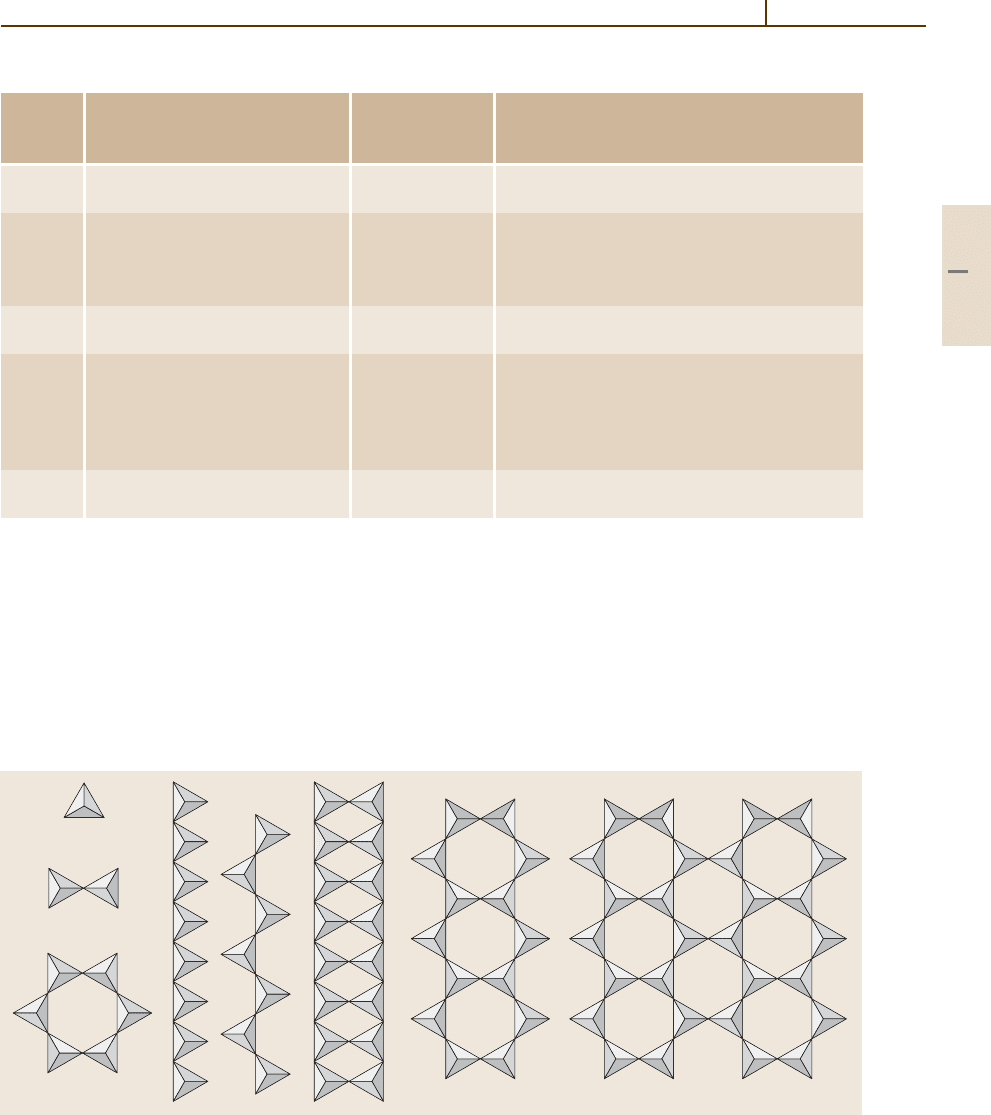
Ceramics 2.2 Silicate Ceramics 433
Table 3.2-3 ASTM Portland cement types [2.4]
ASTM Name Compressive Applications
type
strength after
28 days (MPa)
Type I Normal or ordinary Portland 42 General uses, and hence used when
cement (NPC) no special properties are required.
Type II Modified Portland cement 47 Low heat generation during the hydration
(MPC) process. Most useful in structures with large
cross sections and for drainage pipes where sulfate
levels are low.
Type III Rapid-hardening Portland 52 Used when high strength is required after a short
cement (RHPC) period of curing.
Type IV Low-heat Portland cement 34 Less heat generation during hydration than for Type II.
(LHPC) Used for mass concrete construction where
large heat generation could create problems. The
tricalcium aluminate content must be maintained
below 7 wt%.
Type V Sulfate-resisting Portland 41 Has high sulfate resistance. It is a special cement
cement (SRPC) used when severe attack is possible.
3.2.2 Silicate Ceramics
Silicates are the salts or esters of orthosilicic acid
(H
4
SiO
4
) and of its condensation products. The sili-
cates are categorized according to the arrangement of
the [SiO
4
] tetrahedra in their crystal structure. Fig-
ure 3.2-1 shows some simple, planar arrangements. In
1
2
3
45 6 7 8
Fig. 3.2-1 Schematic representation of the arrangement of the [SiO
4
] tetrahedra in planar silicate crystal structures:
1, nesosilicate; 2, sorosilicate; 3, cyclosilicate; 4 and 5, inosilicates; 6 and 7, ribbon silicates; 8, layered silicate or
phyllosilicate
the tectosilicates, the array of the SiO
4
tetrahedra is
three-dimensional. Typical examples are talc, feldspar,
and the zeolites.
As silicates are the most important constituents of
the earth’s crust, they became the basis of the traditional
Part 3 2.2
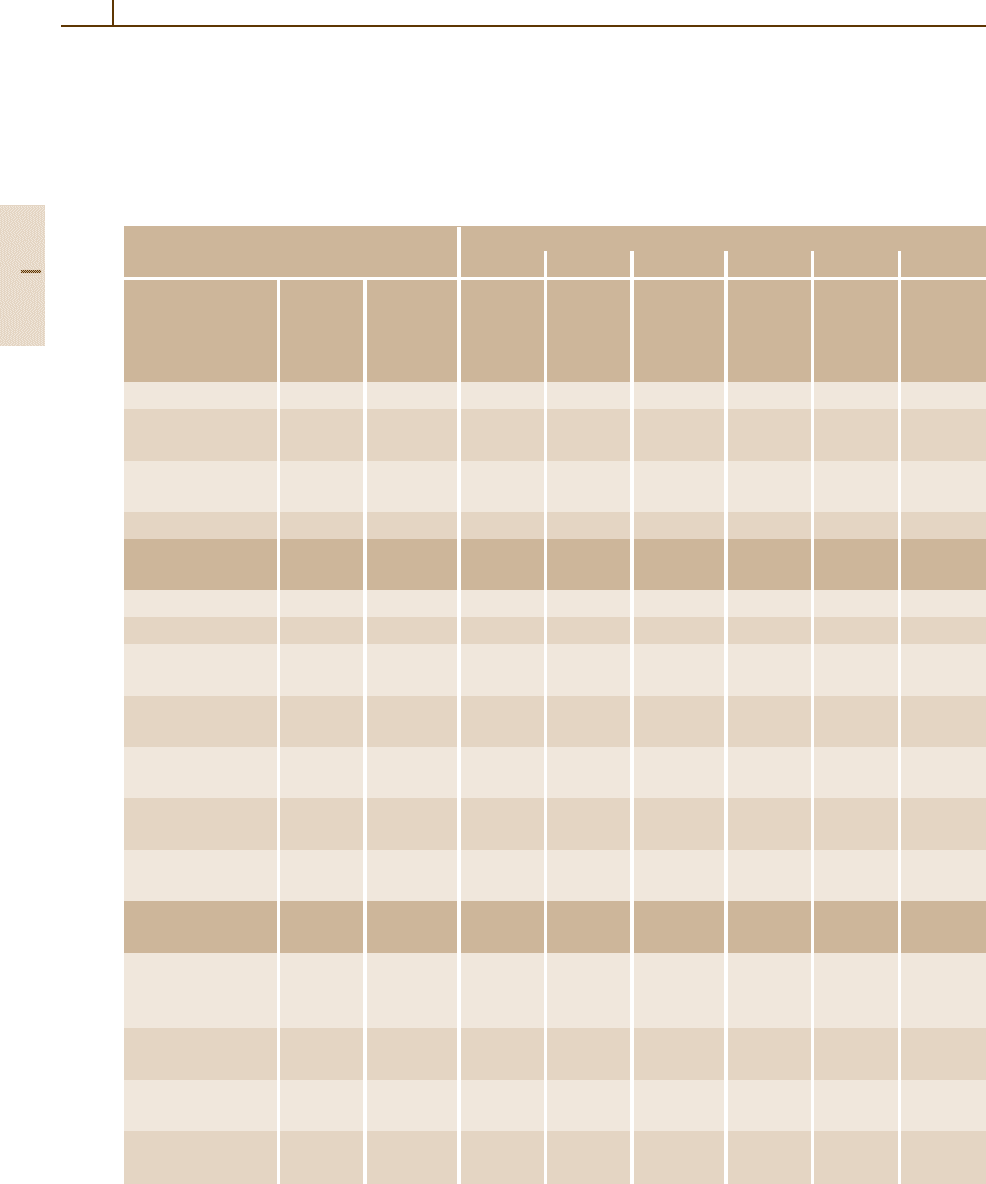
434 Part 3 Classes of Materials
ceramics, from which a variety of technical ceramic
materials have been developed, particularly for elec-
trotechnical and electronic applications. Some silicate
ceramics are also used for high-temperature applications
in the processing of materials. Silicate ceramics are com-
Table 3.2-4 Properties of Alkali aluminium silicates according to DIN EN 60672 [2.6]
Designation
C 110 C 111 C 112 C 120 C 130 C 140
Quartz Quartz Cristobalite Alumina Alumina Lithium
porcelain, porcelain, porcelain porcelain porcelain, porcelain
Mechanical plastically pressed high-
properties Symbol Units formed strength
Density, minimum t/m
3
2 2.2 2.3 2.3 2.5 2.0
Bending strength, σ
ft
MPa 50 40 80 90 140 50
unglazed
Bending strength, σ
fg
MPa 60 − 100 110 160 60
glazed
Young’s modulus E GPa 60 − 70 − 100 −
Electrical
properties
Breakdown strength E
d
kV/mm 20 − 20 20 20 15
Withstand voltage U kV 30 − 30 30 30 20
Permittivity at ε
r
6–7 − 5–6 6–7 6–7.5 5–7
48–62Hz
Loss factor at 20
◦
C, tan δ
pf
10
−3
25 − 25 25 30 10
1kHz
Loss factor at 20
◦
C, tan δ
1M
10
−3
12 − 12 12 15 10
1MHz
Resistivity ρ
20
Ω m 10
11
10
10
10
11
10
11
10
11
10
11
at 20
◦
C
Resistivity ρ
600
Ω m 10
2
10
2
10
2
10
2
10
2
10
2
at 600
◦
C
Thermal
properties
Average coefficient α
30 – 600
10
−6
K
−1
4–7 4–7 6–8 4–7 5–7 1–3
of thermal expansion
at 30–600
◦
C
Specific heat capacity c
p,30 – 600
Jkg
−1
K
−1
750 – 900 800 – 900 800 – 900 750 – 900 800 – 900 750 – 900
at 30–600
◦
C
Thermal λ
30 – 100
Wm
−1
K
−1
1–2.5 1.0–2.5 1.4–2.5 1.2–2.6 1.5 – 4.0 1.0 – 2.5
conductivity
Thermal (Rated) Good Good Good Good Good Good
fatigue resistance
posed essentially of porcelain, steatite, cordierite, and
mullite (3Al
2
O
3
·2SiO
2
).
Recent standards that classify and characterize tech-
nical silicate ceramics are listed in Tables 3.2-4 – 3.2-7.
Part 3 2.2
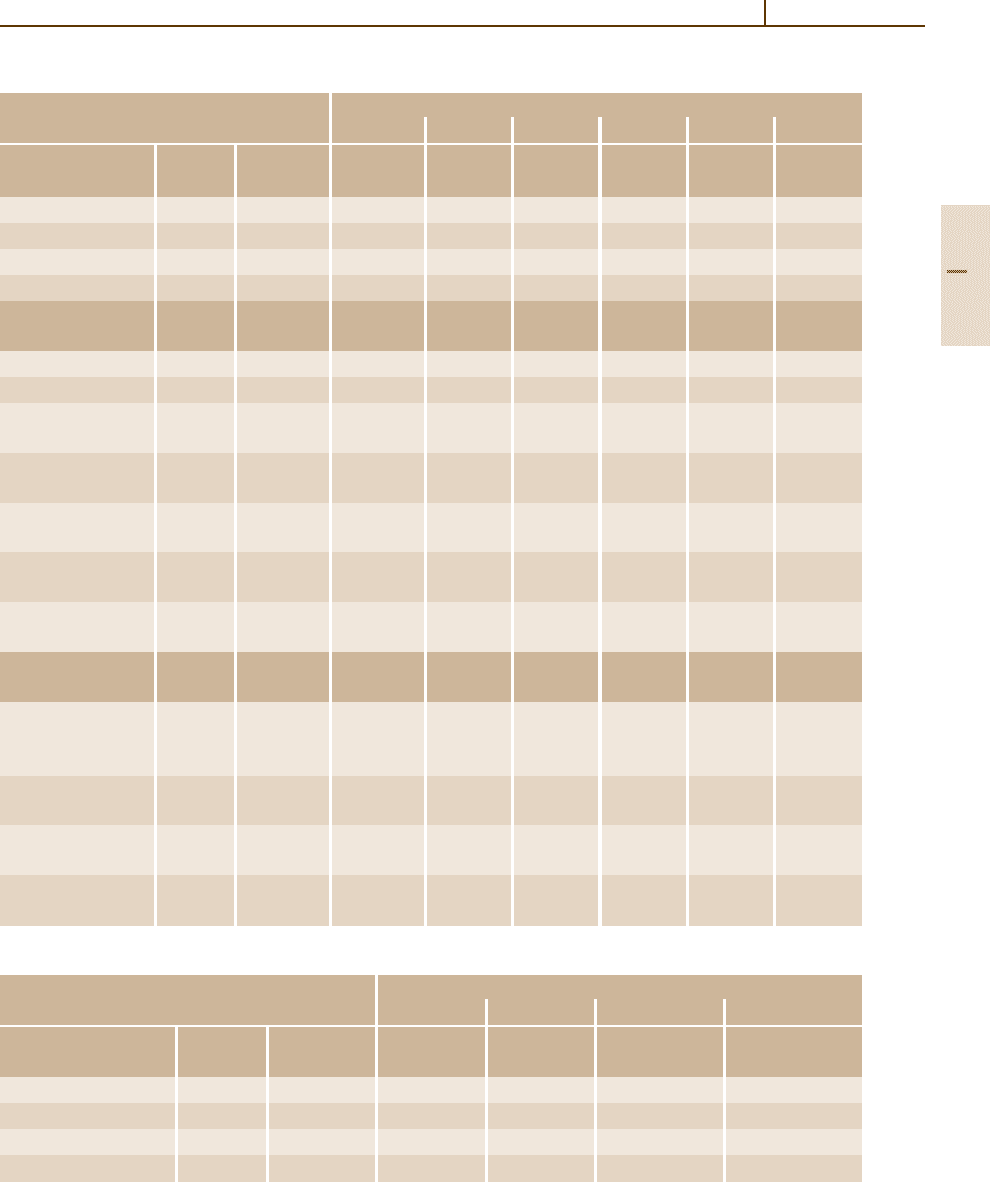
Ceramics 2.2 Silicate Ceramics 435
Table 3.2-5 Properties of magnesium silicate according to DIN EN 60672 [2.6]
Designation
C 210 C 220 C 221 C 230 C 240 C 250
Mechanical Steatite for Steatite, Steatite, Steatite, Forsterite, Forsterite,
properties Symbol Units low voltage standard low-loss porous porous dense
Open porosity vol. % 0.5 0.0 0.0 35.0 30.0 0.0
Density, minimum t/m
3
2.3 2.6 2.7 1.8 1.9 2.8
Bending strength σ
B
MPa 80 120 140 30 35 140
Young’s modulus E GPa 60 80 110 − − −
Electrical
properties
Breakdown strength E
d
kV/mm − 15 20 − − 20
Withstand voltage U kV − 20 30 − − 20
Permittivity at ε
r
6 6 6 − − 7
48–62Hz
Loss factor at 20
◦
C, tanδ
pf
10
−3
25 5 1.5 − − 1.5
1kHz
Loss factor at 20
◦
C, tanδ
1M
10
−3
7 3 1.2 − − 0.5
1MHz
Resistivity ρ
20
Ω m 10
10
10
11
10
11
− − 10
11
at 20
◦
C
Resistivity ρ
600
Ω m 10
3
10
3
10
5
10
5
10
5
10
5
at 600
◦
C
Thermal
properties
Average coefficient α
30−600
10
−6
K
−1
6–8 7–9 7–9 8–10 8–10 9–11
of thermal expansion
at 30–600
◦
C
Specific heat capacity c
p,30−600
Jkg
−1
K
−1
800 – 900 800 – 900 800 – 900 800 – 900 800 – 900 800 – 900
at 30–100
◦
C
Thermal λ
30−100
Wm
−1
K
−1
1–2.5 2–3 2–3 1.5–2 1.4 – 2 3–4
conductivity
Thermal (Rated) Good Good Good Good Good Good
fatigue resistance
Table 3.2-6 Properties of alkaline-earth aluminium silicates according to DIN EN 60672 [2.6]
Designation
C 410 C 420 C 430 C 440
Cordierite, Celsians, Calcium-based, Zirconium-based,
Mechanical properties
Symbol Units dense dense dense dense
Open porosity vol. % 0.5 0.5 0.5 0.5
Density, minimum t/m
3
2.1 2.7 2.3 2.5
Bending strength σ
B
MPa 60 80 80 100
Young’s modulus E GPa − − 80 130
Part 3 2.2

436 Part 3 Classes of Materials
Table 3.2-6 Properties of alkaline-earth aluminium silicates according to DIN EN 60672 [2.6], cont.
Designation
C 410 C 420 C 430 C 440
Cordierite, Celsians, Calcium-based, Zirconium-based,
Electrical properties
Symbol Units dense dense dense dense
Breakdown strength E
d
kV/mm 10 20 15 15
Withstand voltage U kV 15 30 20 20
Permittivity at 48–62 Hz ε
r
5 7 6–7 8–12
Loss factor at 20
◦
C, 1 kHz tan δ
pf
10
−3
25 10 5 5
Loss factor at 20
◦
C, 1 MHz tan δ
1M
10
−3
7 0.5 5.0 5
Resistivity at 20
◦
C ρ
20
Ω m 10
10
10
12
10
11
10
11
Resistivity at 600
◦
C ρ
600
Ω m 10
3
10
7
10
2
10
2
Thermal properties
Average coefficient of thermal α
30−600
10
−6
K
−1
2–4 3.5 – 6 − −
expansion at 30–600
◦
C
Specific heat capacity at c
p,30−600
Jkg
−1
K
−1
800 – 1200 800 – 1000 700 – 850 550 – 650
30–100
◦
C
Thermal conductivity λ
30−100
Wm
−1
K
−1
1.2–2.5 1.5 – 2.5 1–2.5 5–8
Thermal fatigue resistance (Rated) Good Good Good Good
Table 3.2-7 Properties of porous aluminium silicates and magnesium silicates according to DIN EN 60672 [2.6]
Designation
C 510 C 511 C 512 C 520 C 530
Aluminosilicate- Magnesia– Magnesia– Cordierite- Aluminosilicate-
Mechanical
based alumino- alumino- based based
properties
Symbol Units silicate-based silicate-based
Open porosity vol. % 30 20 40 20 30
Density, minimun t/m
3
1.9 1.9 1.8 1.9 2.1
Bending strength σ
B
MPa 25 25 15 30 30
Young’s modulus E GPa − − − 40 −
Electrical
properties
Resistivity ρ
600
Ω m 10
3
10
3
10
3
10
3
10
4
at 600
◦
C
Thermal
properties
Average coefficient α
30−600
10
−6
K
−1
3–6 4–6 3–6 2–4 4–6
of thermal expansion
at 30–600
◦
C
Specific heat capacity c
p,30−600
Jkg
−1
K
−1
750 – 850 750 – 850 750 – 900 750 – 900 800 – 900
at 30–100
◦
C
Thermal conductivity λ
30−100
Wm
−1
K
−1
1.2–1.7 1.3–1.8 1–1.5 1.3–1.8 1.4–2.0
Thermal fatigue Rated Good Good Good Good Good
resistance
Part 3 2.2
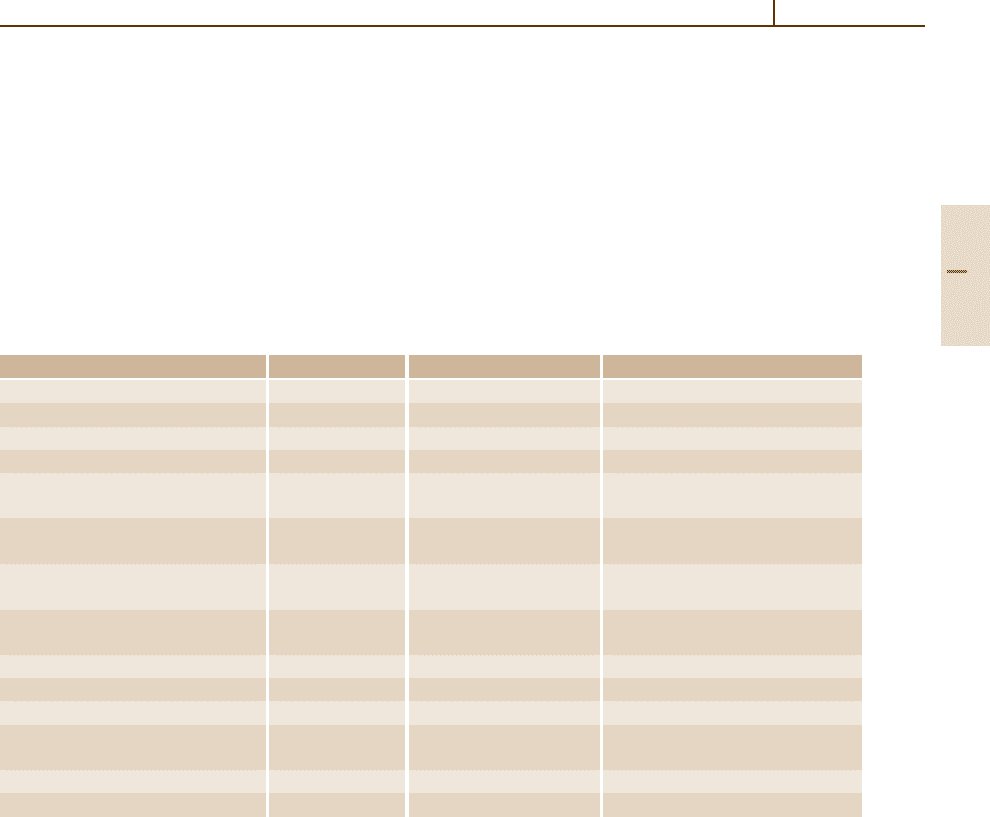
Ceramics 2.4 Oxide Ceramics 437
3.2.3 Refractory Ceramics
Traditional refractory ceramics are produced as bricks
from a broad variety of materials for various ap-
plications, ranging from building bricks used at
ambient and moderately elevated temperatures to high-
temperature refractory grades with particularly high
melting temperatures and refractory stability, such as
magnesite, silicon carbide, stabilized zirconia, and
chrome-magnesite. Table 3.2-8 gives a survey of fired
refractory brick materials.
Table 3.2-8 Properties of fired refractory brick materials [2.4]
Brick (major chemical components) Density (kg/m
3
) Melting temperature (
◦
C) Thermal conductivity κ (W/mK)
Alumina brick (6–65 wt% Al
2
O
3
) 1842 1650 – 2030 4.67
Building brick 1842 1600 0.72
Carbonbrick (99 wt% graphite) 1682 3500 3.6
Chromebrick (100 wt% Cr
2
O
3
) 2900 – 3100 1900 2.3
Crome–magnesite brick 3100 3045 3.5
(52 wt% MgO, 23 wt% Cr
2
O
3
)
Fireclay brick 2146 – 2243 1740 0.3–1.0
(54 wt% SiO
2
,40wt%Al
2
O
3
)
Fired dolomite 2700 2000 –
(55 wt% CaO, 37 wt% MgO)
High-alumina brick 2810 – 2970 1760 – 2030 3.12
(90–99 wt% Al
2
O
3
)
Magnesite brick (95.5 wt% MgO) 2531 – 2900 2150 3.7–4.4
Mullite brick (71 wt% Al
2
O
3
) 2450 1810 7.1
Silica brick (95–99 wt% SiO
2
) 1842 1765 1.5
Silicon carbide brick 2595 2305 20.5
(80–90 wt% SiC)
Zircon (99 wt% ZrSiO
4
) 3204 1700 2.6
Zirconia (stabilized) brick 3925 2650 2.0
It should be noted that these refractory ceramics
in brick form differ from materials classified as tech-
nical refractory ceramics in the amounts of material
used and in the composition, including the impurity
content, but they rely basically on the same oxide or
non-oxide ceramic compounds. These compounds are
used in technical ceramics and are treated in more detail
below.
3.2.4 Oxide Ceramics
Oxides are the most common constituents of all ceram-
ics, traditional and technical. An extensive account is
given in [2.8]. They are used for their physical as well as
refractory properties. Table 3.2-9 presents a systematic
listing of their composition, structure and properties.
Some of the more important oxides are dealt with in
more detail further below.
Part 3 2.4
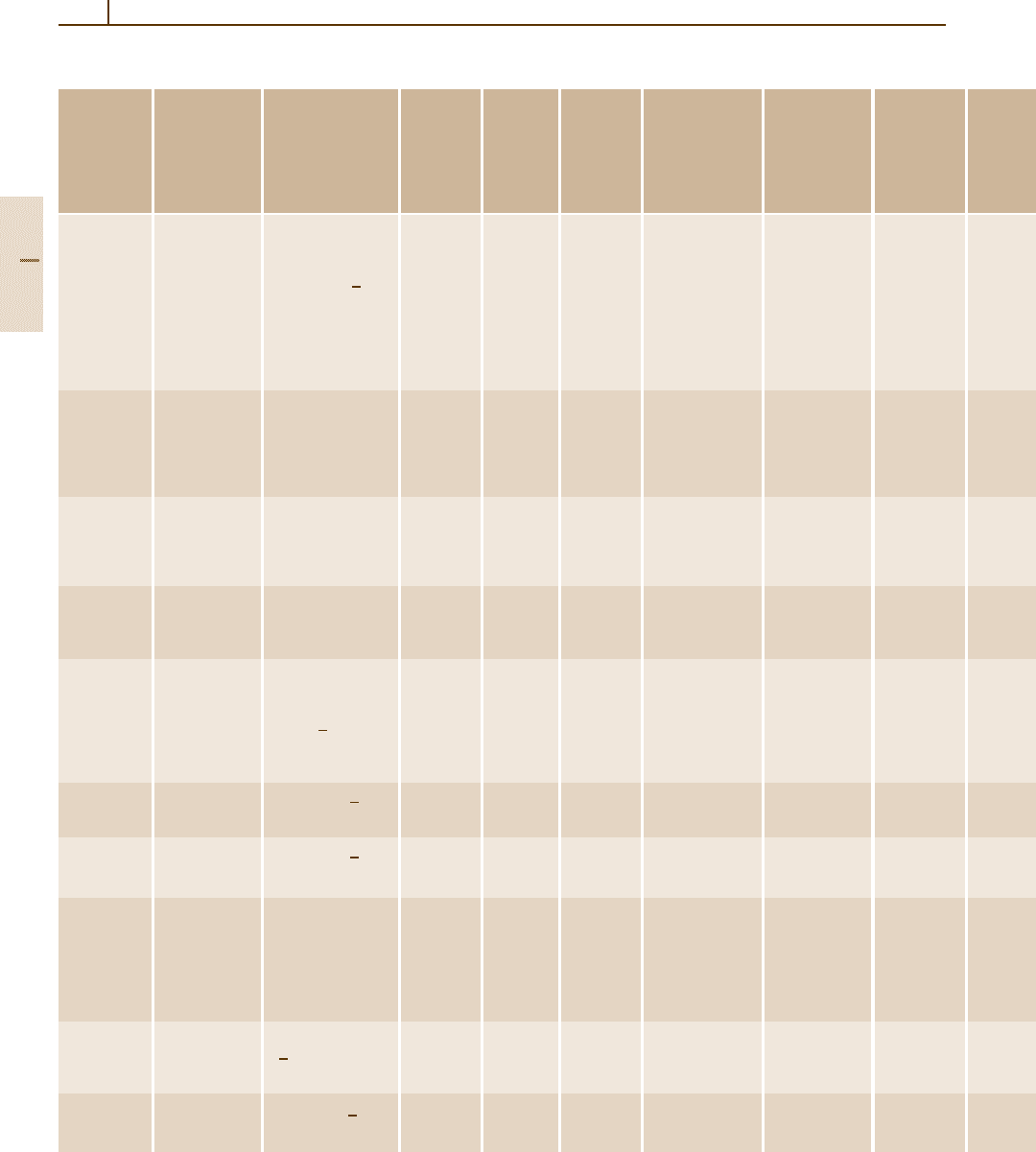
438 Part 3 Classes of Materials
Table 3.2-9 Physical properties of oxides and oxide-based high-temperature refractories [2.4]
IUPAC name
(synonyms
and common
trade names)
Theoretical
chemical
formula,
[CASRN],
relative
molecular mass
(
12
C =12.000)
Crystal system,
lattice parameters,
Strukturbericht
symbol,
Pearson symbol,
space group,
structure type, Z
Density
(,kg m
−3
)
Electrical
resistivity
(ρ,µ cm)
Melting
point (
◦
C)
Thermal
conductivity
(κ,Wm
−1
K
−1
)
Specific heat
capacity
(c
p
,Jkg
−1
K
−1
)
Coefficient
linear
thermal
expansion
(α, 10
−6
K
−1
)
Aluminium
sesquioxide
(alumina,
corundum,
sapphire)
α-Al
2
O
3
[1344-28-1]
[1302-74-5]
101.961
Trigonal
(rhombohedral)
a =475.91 pm
c =1298.4pm
D5
1
, hR10, R3c,
corundum type
(Z = 2)
3987 2×10
23
2054 35.6–39 795.5 – 880 7.1–8.3
Beryllium
monoxide
(beryllia)
BeO
[1304-56-9]
25.011
Trigonal
(hexagonal)
a =270 pm
c =439 pm
B4, hP4, P6
3
mc,
wurtzite type (Z = 2)
3008 – 3030 10
22
2550 – 2565 245 – 250 996.5 7.5–9.7
Calcium
monoxide
(calcia, lime)
CaO
[1305-78-8]
56.077
Cubic
a =481.08 pm
B2, cP2, Pm3m,
CsCl type (Z = 1)
3320 10
14
2927 8–16 753.1 3.88
Cerium
dioxide
(ceria,
cerianite)
CeO
2
[1306-38-3]
172.114
Cubic
a =541.1pm
Cl, cF12, Fm3m,
fluorite type (Z = 4)
7650 10
10
2340 – 389 10.6
Chromium
oxide
(eskolaite)
Cr
2
O
3
[1308-38-9]
151.990
Trigonal
(rhombohedral)
a =538 pm
α = 54
◦
50
D5
1
,
hR10, R
3c,
corundum type
(Z = 2)
5220 1.3×10
9
(346
◦
C)
2330 – 921.1 10.9
Dysprosium
oxide
(dysprosia)
Dy
2
O
3
[1308-87-8]
373.00
Cubic
D5
3
, c180, Ia3,
Mn
2
O
3
type (Z =16)
8300 – 2408 – – 7.74
Europium
oxide
(europia)
Eu
2
O
3
[1308-96-9]
351.928
Cubic
D5
3
, c180, Ia3,
Mn
2
O
3
type (Z =16)
7422 – 2350 – – 7.02
Hafnium
dioxide
(hafnia)
HfO
2
[12055-23-1]
210.489
Monoclinic(1790
◦
C)
a =511.56 pm
b =517.22 pm
c =529.48 pm
C43, mP12, P2
1
c,
baddeleyite type
(Z = 4)
9680 5×10
15
2900 1.14 121 5.85
Gadolinium
oxide
(gadolinia)
Gd
2
O
3
[12064-62-9]
362.50
Cubic
D5
3
, c180,
Ia
3, Mn
2
O
3
type
(Z = 16)
7630 – 2420 – 276 10.44
Lanthanum
dioxide
(lanthana)
La
2
O
3
[1312-81-8]
325.809
Trigonal (hexagonal)
D5
2
, hP5, P3m1,
lanthana type (Z =1)
6510 10
14
(550
◦
C)
2315 – 288.89 11.9
Part 3 2.4
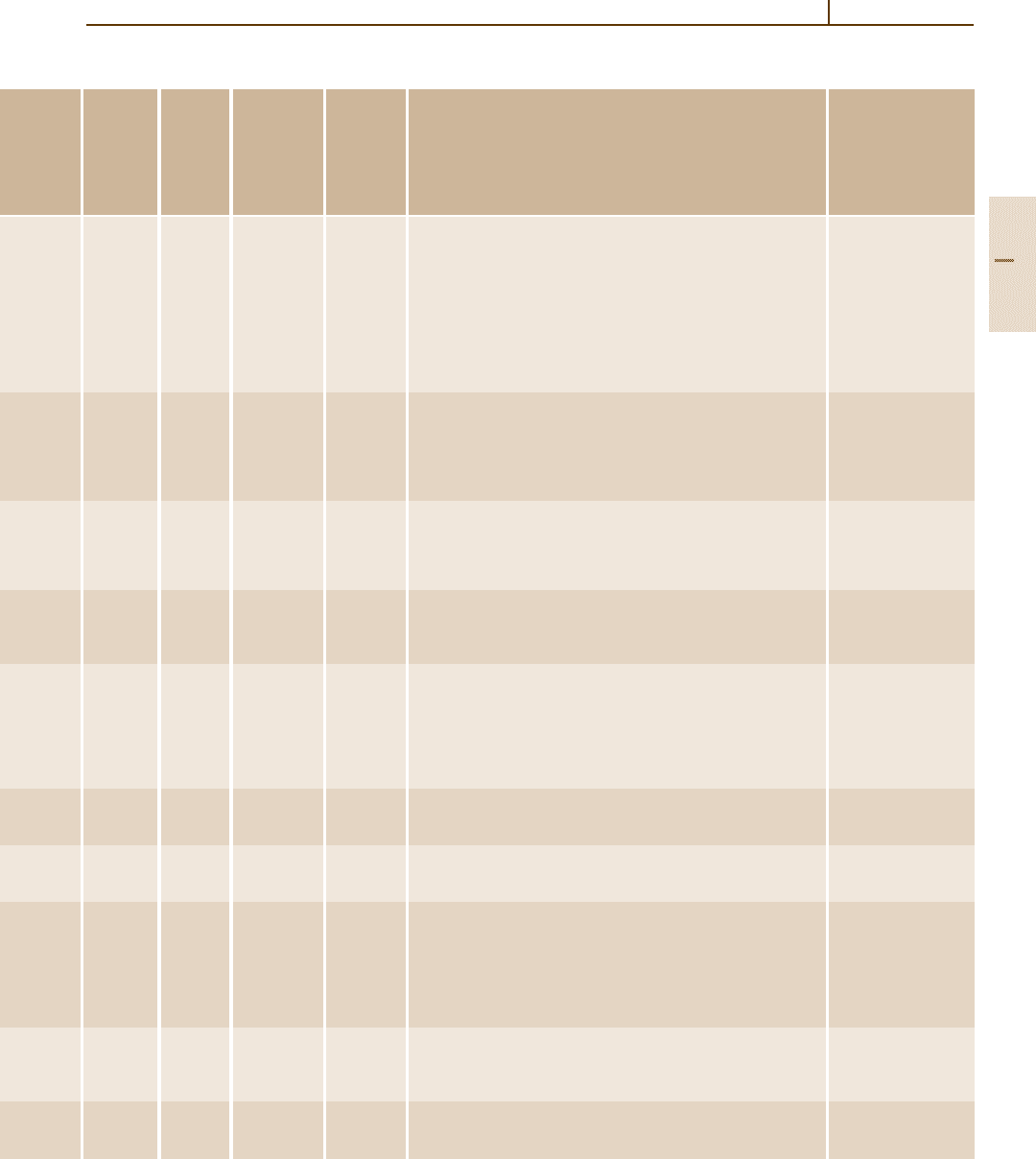
Ceramics 2.4 Oxide Ceramics 439
Table 3.2-9 Physical properties of oxides and oxide-based high-temperature refractories [2.4], cont.
Young’s
modulus
(E,GPa)
Flexural
strength
(τ,MPa)
Compressive
strength
(α,MPa)
Vickers
hardness
HV
(Mohs
hardness
HM)
Other physicochemical properties, corrosion resistance,
a
and uses
IUPAC name
(synonyms
and common
trade names)
365 – 393 282 2549 – 3103 2100 – 3000
(HM 9)
White and translucent; hard material used as abrasive for grinding.
Excellent electrical insulator and also wear-resistent. Insoluble in
water, insoluble in strong mineral acids, readily soluble in strong
solutions of alkali metal hydroxides, attacked by HF and NH
4
HF
2
.
Owing to its corrosion resistance under an inert atmosphere in
molten metals such as Mg, Ca, Sr, Ba, Mn, Sn, Pb, Ga, Bi, As, Sb,
Hg, Mo, W, Co, Ni, Pd, Pt, and U, it is used for crucibles for these
liquid metals. Alumina is readily attacked under an inert
atmosphere by molten metals such as Li, Na, Be, Al, Si, Ti, Zr, Nb,
Ta, and Cu. Maximum service temperature 1950
◦
C.
Aluminium
sesquioxide
(alumina,
corundum,
sapphire)
296.5 – 345 241 – 250 1551 1500
(HM 9)
Beryllium
monoxide
(beryllia)
– – – 560
(HM 4.5)
Forms white or grayish ceramics. It is readily absorbs CO
2
and
water from air to form calcium carbonate and slaked lime. It reacts
readily with water to give Ca(OH)
2
. Volumetric expansion
coefficient 0.225× 10
−9
K
−1
. It exhibits outstanding corrosion
resistance in the following liquid metals: Li and Na.
Calcium
monoxide
(calcia, lime)
181 – 589 (HM 6) Pale yellow cubic crystals. Abrasive for polishing glass; used in
interference filters and antireflection coatings. Insoluble in water,
soluble in H
2
SO
4
and HNO
3
, but insoluble in dilute acids.
Cerium
dioxide
(ceria,
Cerianite)
– – – (HM > 8) Chromium
oxide
(eskolaite)
– – – – Dysprosium
oxide
(dysprosia)
– – – – Europium
oxide
(europia)
57 – – 780 – 1050 Hafnium
dioxide
(hafnia)
124 – – 480 Gadolinium
oxide
(gadolinia)
– – – – Insoluble in water, soluble in dilute strong mineral acids. Lanthanum
dioxide
(lanthana)
Part 3 2.4
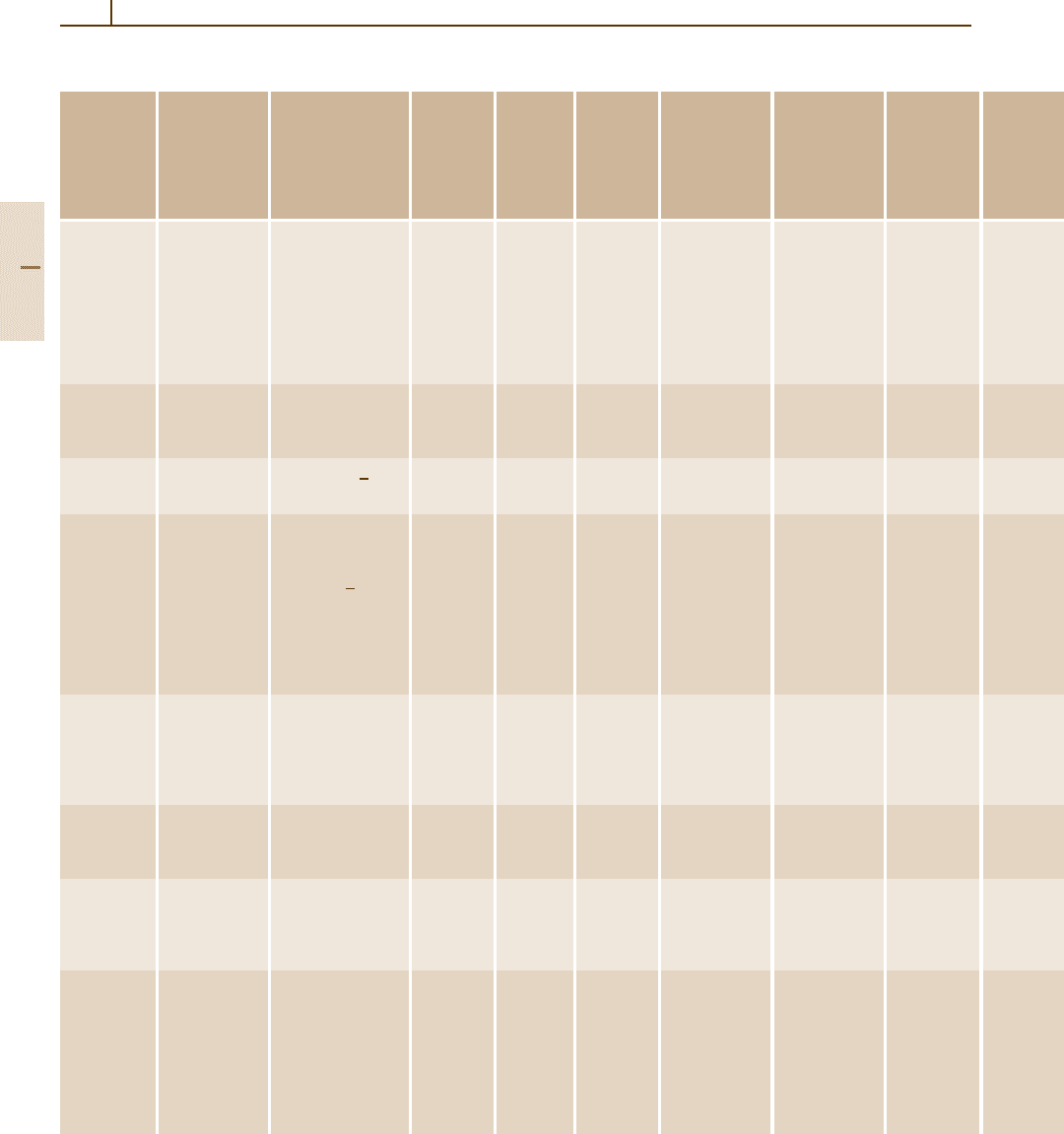
440 Part 3 Classes of Materials
Table 3.2-9 Physical properties of oxides and oxide-based high-temperature refractories [2.4], cont.
IUPAC name
(synonyms
and common
trade names)
Theoretical
chemical
formula,
[CASRN],
relative
molecular mass
(
12
C =12.000)
Crystal system,
lattice parameters,
Strukturbericht
symbol,
Pearson symbol,
space group,
structure type, Z
Density
(,kg m
−3
)
Electrical
resistivity
(ρ,µ cm)
Melting
point (
◦
C)
Thermal
conductivity
(κ, Wm
−1
K
−1
)
Specific heat
capacity
(c
p
,Jkg
−1
K
−1
)
Coefficient
of linear
thermal
expansion
(α,10
−6
K
−1
)
Magnesium
monoxide
(magnesia,
periclase)
MgO
[1309-48-4]
40.304
Cubic
a =420 pm
B1, cF8, Fm3m,
rock salt type
(Z = 4)
3581 1.3×10
15
2852 50–75 962.3 11.52
Niobium
pentoxide
(columbite,
niobia)
Nb
2
O
5
[1313-96-8]
265.810
Numerous
polytypes
4470 5.5×10
12
1520 – 502.41 –
Samarium
oxide
(samaria)
Sm
2
O
3
[12060-58-1]
348.72
Cubic
D5
3
, c180, Ia3,
Mn
2
O
3
type (Z =16)
7620 – 2350 2.07 331 10.3
Silicon
dioxide
(silica,
α-quartz)
α-SiO
2
[7631-86-9]
[14808-60-7]
60.085
Trigonal
(rhombohedral)
a =491.27 pm
c =540.46 pm
C8, hP9, R
3c,
α-quartz type
(Z = 3)
2202 – 2650 10
20
1710 1.38 787 0.55
Tantalum
pentoxide
(tantalite,
tantala)
Ta
2
O
5
[1314-61-0]
441.893
Trigonal
(rhombohedral)
columbite type
8200 10
12
1882 – 301.5 –
Thorium
dioxide
(thoria,
thorianite)
ThO
2
[1314-20-1]
264.037
Cubic
a =559 pm
Cl, cF12, Fm3m,
fluorite type (Z = 4)
9860 4×10
19
3390 14.19 272.14 9.54
Titanium
dioxide
(anatase)
TiO
2
[13463-67-7]
[1317-70-0]
79.866
Tetragonal
a =378.5pm
c =951.4pm
C5, tI12, I 4
1
amd,
anatase type (Z = 4)
3900 – 700
◦
C
(rutile)
– – –
Titanium
dioxide
(brookite)
TiO
2
[13463-67-7]
79.866
Orthorhombic
a =916.6pm
b =543.6pm
c =513.5pm
C21, oP24, Pbca,
brookite type (Z =8)
4140 – 1750 – – –
Part 3 2.4
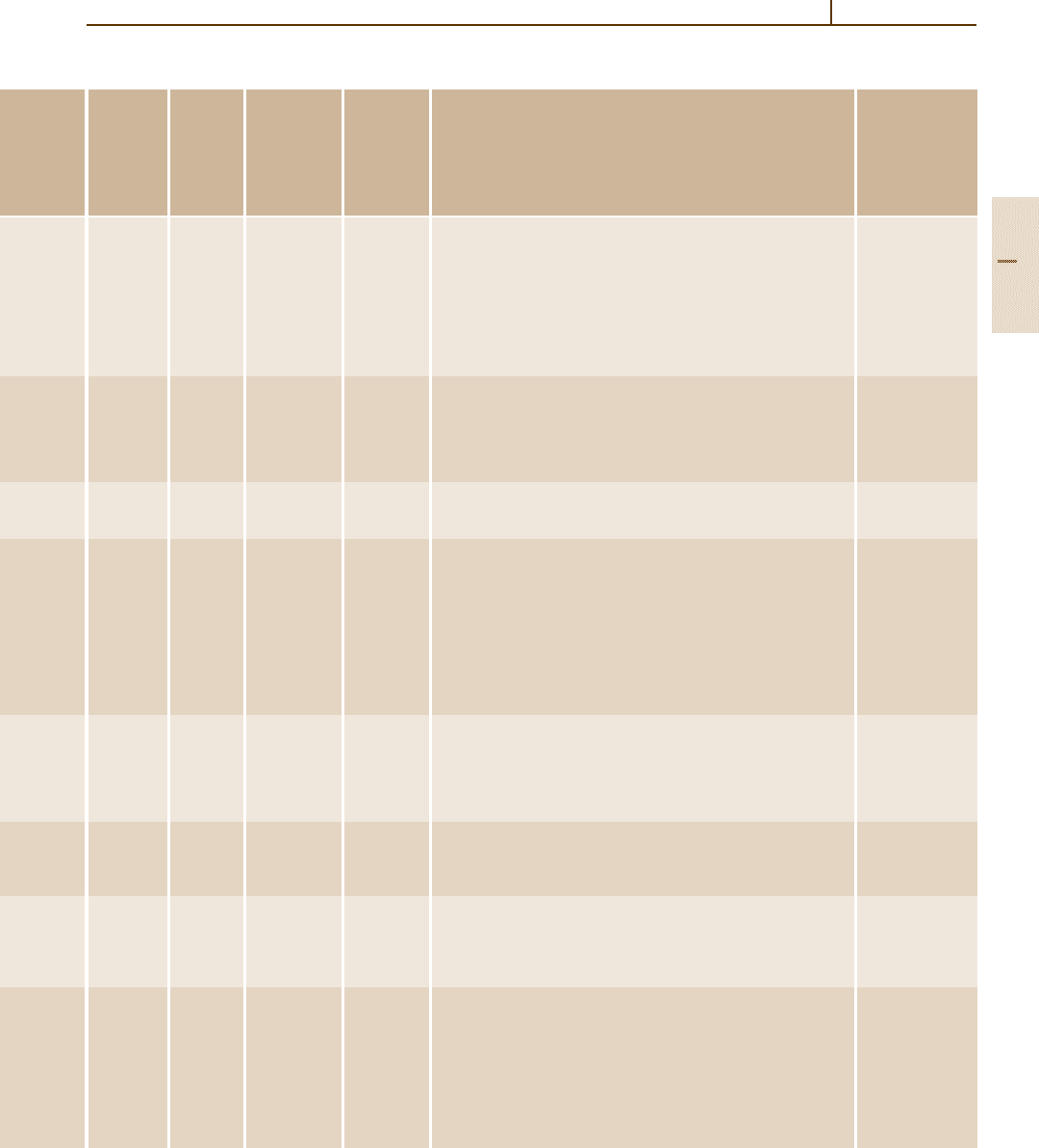
Ceramics 2.4 Oxide Ceramics 441
Table 3.2-9 Physical properties of oxides and oxide-based high-temperature refractories [2.4], cont.
Young’s
modulus
(E,GPa)
Flexural
strength
(τ,MPa)
Compressive
strength
(α,MPa)
Vickers
hardness
HV
(Mohs
hardness
HM)
Other physicochemical properties, corrosion resistance,
a
and uses
IUPAC name
(synonyms
and common
trade names)
303.4 441 1300 – 1379 750
(HM 5.5−6)
Forms ceramics with a high reflection coefficient in the visible and
near-UV region. Used in linings for steelmaking furnaces and in
crucibles for fluoride melts. Very slowly soluble in pure water; but
soluble in dilute strong mineral acids. It exhibits outstanding
corrosion resistance in the following liquid metals: Mg, Li, and Na.
It is readily attacked by molten metals such as Be, Si, Ti, Zr, Nb,
and Ta. MgO reacts with water, CO
2
, and dilute acids. Maximum
service temperature 2400
◦
C. Transmittance of 80 % and refractive
index of 1.75 in the IR region from 7 to 300µm.
Magnesium
monoxide
(magnesia,
periclase)
– – – 1500 Dielectric used in film supercapacitors. Insoluble in water; soluble
in HF and in hot concentrated H
2
SO
4
.
Niobium
pentoxide
(columbite,
niobia)
183 – – 438 Samarium
oxide
(samaria)
72.95 310 680 – 1380 550 – 1000
(HM 7)
Colorless amorphous (fused silica) or crystalline (quartz) material
having a low thermal expansion coefficient and excellent optical
transmittance in the far UV. Silica is insoluble in strong mineral
acids and alkalis except HF, concentrated H
3
PO
4
,NH
4
HF
2
and
concentrated alkali metal hydroxides. Owing to its good corrosion
resistance to liquid metals such as Si, Ge, Sn, Pb, Ga, In, TI, Rb, Bi,
and Cd, it is used in crucibles for melting these metals. Silica is
readily attacked under an inert atmosphere by molten metals such
as Li, Na, K, Mg, and Al. Quartz crystals are piezoelectric and
pyroelectric. Maximum service temperature 1090
◦
C.
Silicon
dioxide
(silica,
α-quartz)
– – – – Dielectric used in film supercapacitors. Tantalum oxide is a
high-refractive index, low-absorption material usable for making
optical coatings from the near-UV (350 nm) to the IR (8 µm).
Insoluble in most chemicals except HF, HF
−
HNO
3
mixtures,
oleum, fused alkali metal hydroxides (e.g. NaOH and KOH) and
molten pyrosulfates.
Tantalum
pentoxide
(tantalite,
tantala)
144.8 – 1475 945
(HM 6.5)
Corrosion-resistant container material for the following molten
metals: Na, Hf, Ir, Ni, Mo, Mn, Th, U. Corroded by the following
liquid metals: Be, Si, Ti, Zr, Nb, Bi. Radioactive.
Thorium
dioxide
(thoria,
thorianite)
– – – (HM 5.5–6) Titanium
dioxide
(anatase)
– – – (HM 5.5–6) Titanium
dioxide
(brookite)
Part 3 2.4
